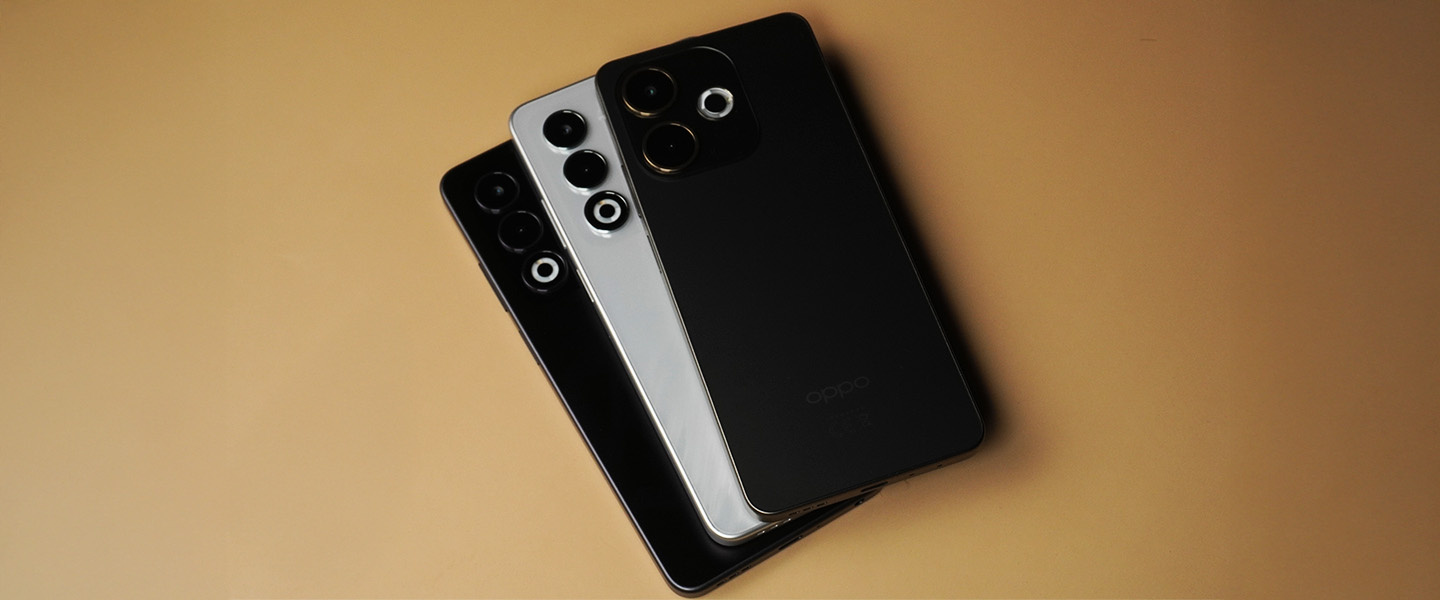The OPPO A5, A5 5G, and A5 Pro 5G are clearly cut from the same cloth. They each have big batteries, sturdy builds, and sensible price tags. But there are some key differences here, and depending on what you care about most, 5G, speed, storage, or sturdiness, one of these three will suit you better than the others.
In this article we’ll break it all down to help you figure out which model might be right for you.
What they all have in common
All three models share a solid foundation. They all come with a 6.67-inch LCD screen running at HD+ resolution. They’re all IP-rated for water and dust resistance. They each have a 50MP main camera on the back, run Android 15 out of the box, and include OPPO’s side-mounted fingerprint reader. There’s a big battery inside each one, and fast 45W SuperVOOC charging compatibility.
You’re also getting expandable storage via microSD, facial recognition, and military-grade drop protection across the board. So even if you go for the cheapest model, you’re not missing out on those key practical features.
Quick Comparison
| Feature | OPPO A5 ($299) | OPPO A5 5G ($349) | OPPO A5 Pro 5G ($499) |
|---|---|---|---|
| Display | 6.67" HD+ LCD, 90Hz | 6.67" HD+ LCD, 120Hz | 6.67" HD+ LCD, 120Hz |
| Processor | Snapdragon 6s Gen 1 (4G) | Dimensity 6300 (5G) | Dimensity 6300 (5G) |
| RAM / Storage | 6GB + 128GB | 6GB + 128GB | 8GB + 256GB |
| Rear Camera | 50MP + 2MP depth | 50MP + 2MP depth | 50MP + 2MP depth |
| Front Camera | 5MP | 8MP | 8MP |
| Video Features | Dual-view video only | Dual-view + slow motion | Dual-view + slow motion |
| Battery | 6000mAh | 6000mAh | 5800mAh |
| Charging | 45W SuperVOOC (included) | 45W SuperVOOC (included) | 45W SuperVOOC (included) |
| Water/Dust Resistance | IP65 | IP65 | IP69 |
| Speakers | Mono | Mono | Stereo |
| Headphone Jack | Yes | Yes | No |
| OS / Software | Android 15 / ColorOS 15 | Android 15 / ColorOS 15 | Android 15 / ColorOS 15 |
| Extras | microSD, fingerprint, face unlock | microSD, fingerprint, face unlock | Gorilla Glass 7i, extra rugged |
Price
The OPPO A5 is selling for $299. It’s the most affordable in the range and sticks to 4G-only connectivity.
The A5 5G costs $349 and brings a noticeable bump in performance, along with support for 5G networks.
At the top of the lineup, the A5 Pro 5G comes in at $499. This is aimed at users who want a bit more of everything, more RAM, more storage, tougher water protection, and stereo speakers.
The jump from A5 to A5 5G is relatively small, and for just $50 more you get a lot of meaningful upgrades. But stepping up to the Pro means a more rugged and capable device, and the price reflects that.


Design and durability
All three phones are almost identical in shape, size, and layout, with curved edges, a textured matte back, and a modern overall finish.
Both the A5 and A5 5G are rated IP65, meaning they’ll survive splashes and dust exposure without a problem. The A5 Pro 5G takes things further with an IP69 rating, which protects it from high-pressure water jets and heat. That makes it a stronger option for more demanding environments. It also changes the regular glass on the front for the more durable Gorilla Glass 7i, giving it extra protection.
Unlike the other two, the Pro doesn’t have a headphone jack, and another key difference is speakers. The A5 and A5 5G both use a single bottom-firing speaker. The Pro adds stereo sound, which is noticeably better when watching videos or playing games without headphones.
Display
All three models feature the same 6.67-inch HD+ LCD panel. It’s not the sharpest display around, these are 720p screens, after all, but brightness is excellent, and colours look good. Peak brightness reaches around 1000 nits, which is plenty for outdoor use, even on sunny days.
Where things differ is in refresh rate. The standard A5 runs at 90Hz, which already feels smoother than your typical 60Hz budget phone. The A5 5G and A5 Pro 5G step things up to 120Hz, which makes scrolling feel even slicker. You’ll definitely notice the difference if you’re coming from an older or lower-end phone.
Performance
This is where the series really starts to split. The A5 is powered by the Snapdragon 6s Gen 1 processor. It’s a 4G-only chip that handles day-to-day tasks like browsing, messaging, YouTube, and light gaming without any major issues. It’s paired with 6GB of RAM and 128GB of storage, which is fine for most users.
Move up to the A5 5G, and you get the MediaTek Dimensity 6300. It’s noticeably faster in general use and, as the name suggests, supports full 5G connectivity. That makes a real difference if you’re in an area with strong coverage or just want to futureproof your device. It still ships with 6GB of RAM and 128GB of storage, just like the standard model.
The A5 Pro 5G uses the same Dimensity 6300 chip but bumps the RAM up to 8GB and the storage to 256GB. That’s a big step forward if you’re running lots of apps, switching between tasks often, or storing a ton of photos and videos on your phone. All three support OPPO’s RAM expansion feature too, which helps keep things running smoothly by allocating extra memory from your unused storage.
Cameras
Camera hardware is consistent across the range. Each model comes with a 50MP main camera on the back, paired with a 2MP depth sensor for portrait mode. Daylight photos are sharp and vibrant across all three phones. You’re not getting an ultra-wide or zoom lens, but at this price point, that’s to be expected.
Where you’ll notice a difference is on the front. The A5 has a 5MP selfie camera, while the A5 5G and A5 Pro 5G both upgrade that to 8MP. That might not sound huge, but it does lead to clearer shots and smoother video calls, especially in lower light situations.
In terms of features, all three phones support dual-view video, which lets you record using both the front and rear cameras at once. Only the two 5G models include slow-motion video recording at 120 frames per second. The A5 doesn’t offer that option.


Gaming
If you’re planning to game on your phone there are some clear differences between these three.
Starting with the OPPO A5, it’ll run casual games just fine. Games like Candy Crush or Clash Royale run without issue. But once you step into heavier titles like Call of Duty: Mobile or PUBG, you’ll start to hit the limits. The Snapdragon chip inside can handle them on low settings, but you’re going to notice slower load times, occasional stutter, and less consistent frame rates.
The A5 5G handles things better. The Dimensity 6300 is a more capable processor, and it pairs nicely with the smoother 120Hz screen. Games feel more responsive and you can comfortably push graphics up a notch in many cases. It’s not going to rival a proper gaming phone, but for under $350, it holds its own.
Then there’s the A5 Pro 5G, which takes everything the A5 5G does and adds a bit more headroom. The extra RAM helps with loading times and keeps things running smoothly if you’re switching between apps mid-game. Plus, the Pro is the only one with stereo speakers, which makes a surprising difference when you're playing without headphones.


Battery life
This is a strong point for the whole range. The A5 and A5 5G come with a massive 6000mAh battery, while the A5 Pro 5G drops only slightly to 5800mAh. In everyday use, you’ll be getting well over a day, and for lighter users, two days is definitely possible.
Charging is handled by OPPO’s 45W SuperVOOC system. You can expect to get from 0 to around 50% in just over half an hour. OPPO also claims that these batteries will hold at least 80% of their capacity after four to five years of regular use, so they’re built for the long haul.
Final thoughts
The OPPO A5 series is all about giving you practical features that matter day-to-day, long battery life, solid durability, fast charging, and a clean user experience.
If you just want something reliable, affordable, and simple, the OPPO A5 is a safe bet. If you want something a bit quicker, with 5G and a sharper front camera, the A5 5G hits the sweet spot. And if you’re after more power, more storage, better audio, and durability, the A5 Pro 5G will be a better option.
They’re all built to last, it just depends on how far you want to go and how many features you need.








